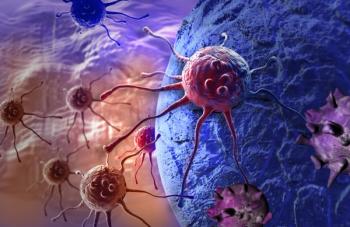
- ONCOLOGY Nurse Edition Vol 24 No 7
- Volume 24
- Issue 7
Preventing Infection in Patients With Cancer
Through evidence-based clinical practice, research, and patient teaching, nurses play an important role in addressing infection risk, and in managing infections, in patients with cancer.
Through evidence-based clinical practice, research, and patient teaching, nurses play an important role in addressing infection risk, and in managing infections, in patients with cancer. In their article, Cheryl Lee and Christopher Friese present an excellent comprehensive and contemporary review of current diagnostic and treatment strategies to prevent and manage bacterial infections in adult patients with solid tumors. The authors also provide references for key evidence-based infection-prevention guidelines. This review will highlight several areas in which oncology nurses are in a unique position to prevent infection through nursing practice and patient education.
Central Venous Catheter Care
Central venous catheter (CVC)-related bloodstream infections (CRBSI) are common in cancer patients, and meticulous attention to the care of CVCs can prevent infection.[1,2] The Centers for Disease Control and Prevention (CDC) has established guidelines for prevention of intravascular catheter-related infections. The current guidelines were published in 2002, however, a draft of newly revised guidelines was released for public comment in November 2009; a summary of the recommendations relevant to CVC care in oncology patients will be provided here (O'Grady, et al., in press).[3]
Nurses should begin CVC care with hand hygiene. Either clean or sterile gloves can be worn when changing the CVC dressing. The CVC site should be disinfected with 2% chlorhexidine. If there is a contraindication to chlorhexidine, then tincture of iodine, an iodophor, or 70% alcohol can be used as an alternative. Either sterile gauze or a sterile, transparent, semipermeable dressing may be used to cover the catheter site.
For nontunneled CVCs, gauze dressings should be changed every 2 days and transparent dressings should be changed at least every 7 days. Tunneled or implanted CVC dressings may be changed once a week until the exit site has healed; tunneled CVC sites that are well healed might not require dressings. A chlorhexidine-impregnated sponge dressing may be used to decrease the risk of CRBSI with short-term catheters. Topical antibiotic ointment or creams are not recommended for use on insertion sites because of their potential to promote fungal infections and antimicrobial resistance.
For peripheral inserted central catheters (PICC), a sutureless securement device reduces the risk of infection. If the patient is diaphoretic, or if the site is bleeding or oozing, a gauze dressing is preferable to a transparent, semipermeable dressing; however, any dressing that becomes damp, loosened, or visibly soiled should be changed. The catheter should not be submerged in water, and patients must take care to protect the CVC site with an impermeable cover while showering. Administration sets should not be replaced more frequently than 72–96 hours, and recent data suggest that it is safe to use administration sets for up to 7 days. However, tubing used to administer blood, blood products, total parenteral nutrition, or lipids should be changed every 24 hours. Needleless systems are preferred, and caps should be changed with the administration set. Injection ports should be vigorously swabbed with 70% alcohol, chlorhexidine, or an iodophor before use.
Hand Hygiene
Hand hygiene has proven to be one of the most effective ways to prevent the transmission of infection.[4,5] Friese and Lee nicely review the significance of hand hygiene as well as the appropriate hand-washing technique. Hand hygiene cannot be emphasized enough, however; despite the knowledge that hand-washing decreases the risk of infection, clinicians are not always compliant in washing their hands before and after patient contact. Furthermore, most oncology patients are outpatient and it is critical that nurses educate patients about the importance of hand hygiene for themselves and their close contacts.
Food Safety
In the 1970s, research established that foods, particularly fresh fruits and vegetables, contain Escherichia coli, Pseudomonas aeruginosa, and other gram-negative bacilli.[6] These observations led to the implementation of dietary restrictions for neutropenic cancer patients, commonly referred to as a low microbial or “neutropenic” diet. Nearly all healthcare institutions surveyed in the 2000s recommended a neutropenic diet to their patients, and the most common recommendation was to avoid uncooked fruits and vegetables.[7–11]
Current research suggests that dietary restrictions beyond customary food safety practices are unlikely to decrease the risk of infection, however. In one study, 30% of 23 outpatients were noncompliant with the neutropenic diet and infection rates were similar in compliant and noncompliant patients.[12] Another small trial showed no difference in the rate of febrile neutropenia between patients who were randomly assigned to a US Food and Drug Administration–approved food safety diet or a diet that included restriction of fresh fruits and vegetables. Similarly, a randomized trial of 20 patients with hematologic malignancies found no differences in gut colonization or infection between patients on a normal hospital diet and patients on a low bacterial diet.[13] The largest trial to date evaluated 153 patients who underwent induction chemotherapy for either acute myelogenous leukemia (AML) or myelodysplastic syndrome (MDS), and there was no significant difference in the rate of infection between those were randomized to a diet with fresh fruits and vegetables vs a diet that restricted raw fruits and vegetables.[6] Therefore, low microbial (“neutropenic”) diets that restrict uncooked fruits and vegetables are not recommended to prevent infection in neutropenic cancer patients. Basic food safety principles are recommended, however, such as avoiding uncooked meats, seafood, eggs, and unwashed fruits and vegetables. The United States Department of Agriculture offers an informative, easy-to-read guide, “Food Safety for People with Cancer,” that provides practical food safety advice to help patients reduce their risk of foodborne illness.[14]
Prevention of infection decreases morbidity and mortality and ensures that patients receive optimal cancer treatment. Nurses are ideally situated to provide proactive care and practical information to minimize the risk of infection. In their article, Lee and Friese have provided many useful tools to help us achieve this goal.
Financial Disclosure:The author has no significant financial interest or other relationship with the manufacturers of any products or providers of any service mentioned in this article.
References:
References
1.Raad I, Hachem R, Hanna H, et al: Sources and outcome of bloodstream infections in cancer patients: The role of central venous catheters. Eur J Clin Microbiol Infect Dis 26(8):549â556, 2007.
2. Seifert H, Cornely O, Seggewiss K, et al: Bloodstream infection in neutropenic cancer patients related to short-term nontunnelled catheters determined by quantitative blood cultures, differential time to positivity, and molecular epidemiological typing with pulsed-field gel electrophoresis. J Clin Microbiol 41(1):118â123, 2003.
3. O'Grady NP, Alexander M, Burns LA, et al: Guidelines for the prevention of intravascular catheter-related infections (draft, in press). Centers for Disease Control and Prevention. Available at:
4. Boyce JM, Pittet D, et al: Guideline for Hand Hygiene in Health-Care Settings: Recommendations of the Healthcare Infection Control Practices Advisory Committee and the HICPAC/SHEA/APIC/IDSA Hand Hygiene Task Force. Infect Control Hosp Epidemiol 23(12 suppl): 2002.
5. Sehulster L, Chinn RY: Guidelines for environmental infection control in health-care facilities: Recommendations of CDC and the Healthcare Infection Control Practices Advisory Committee (HICPAC). MMWR Recomm Rep 52 (RR-10):1â42, 2003.
6. Gardner A, Mattiuzzi G, Faderl S, et al: Randomized comparison of cooked and noncooked diets in patients undergoing remission induction therapy for acute myeloid leukemia. J Clin Oncol 26(35):5684â5688, 2008.
7. Smith LH, Besser SG: Dietary restrictions for patients with neutropenia: A survey of institutional practices. Oncol Nurs Forum 27(3):515â520, 2000.
8. Wilson BJ: Dietary recommendations for neutropenic patients. Semin Oncol Nurs 18(1):44â49, 2002.
9. Larson E, Nirenberg A: Evidence-based nursing practice to prevent infection in hospitalized neutropenic patients with cancer. Oncol Nurs Forum 31(4):717â725, 2004.
10. Moody K, Charlson ME, Finlay J: The neutropenic diet: What's the evidence? J Pediatr Hematol Oncol 24(9):717â721, 2002.
11. Somerville ET: Special diets for neutropenic patients: Do they make a difference? Semin Oncol Nurs 2(1):55â58, 1986.
12. DeMille D, Deming P, Lupinacci P, et al: The effect of the neutropenic diet in the outpatient setting: A pilot study. Oncol Nurs Forum 33(2):337â343, 2006.
13. van Tiel F, Harbers MM, Terporten PH, et al: Normal hospital and low-bacterial diet in patients with cytopenia after intensive chemotherapy for hematological malignancy: A study of safety. Ann Oncol 18(6):1080â1084, 2007.
14. United States Department of Agriculture: Food Safety for People with Cancer. Available at:
Articles in this issue
over 15 years ago
ONCOLOGY Nurse Edition Continuing Medical Education July 2010over 15 years ago
Venous Thromboembolism in a Gynecologic Cancer Patientover 15 years ago
Energy Therapiesover 15 years ago
Bacterial Infections in Patients With Solid Tumorsover 15 years ago
Chronic Diarrhea in Post-treatment Colorectal Cancer Survivorsover 15 years ago
Quality Care Depends on Knowledge and Actionover 15 years ago
Near Misses: Free Lessons for Safer CareNewsletter
Stay up to date on recent advances in the multidisciplinary approach to cancer.





















































































